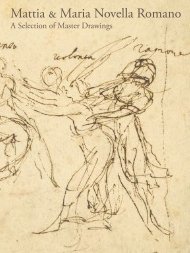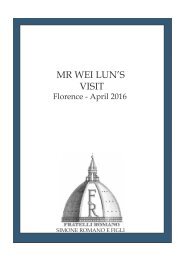A Selection of master drawings 2014
- No tags were found...
Create successful ePaper yourself
Turn your PDF publications into a flip-book with our unique Google optimized e-Paper software.
11. Pietro Antonio Novelli<br />
Venice 1729 - 1804<br />
Gallant Scene (Capriccio)<br />
Pen, ink and watercolours on laid paper<br />
293 x 198 mm. (11½ x 7 ¾ in.)<br />
Inscriptions<br />
on the old mount, top right corner, in ink, n. 7; bottom left corner, in ink, Tiepolo.<br />
In his detailed autobiography, a primary source<br />
reconstructing his artistic career, Pietro Antonio Novelli<br />
reports that the habit <strong>of</strong> constantly drawing, intended as an<br />
essential element <strong>of</strong> knowledge, was passed onto him in his<br />
youth in his native Venice by his preceptor don Pietro Toni,<br />
a passionate collector <strong>of</strong> prints and <strong>drawings</strong> by the great<br />
Venetian <strong>master</strong>s. In 1754, Novelli was nominated Pr<strong>of</strong>essor<br />
at the Accademia delle Arti, for which he painted the Allegory<br />
<strong>of</strong> the Arts (Venice, Gallerie dell’Accademia), highly praised<br />
by his contemporaries. Following this success, he produced<br />
a number <strong>of</strong> paintings in Venice such as The Last Supper<br />
for the church <strong>of</strong> San Lazzaro degli Armeni (1780-1781)<br />
and the signed and dated (1789) painting <strong>of</strong> the Vision<br />
<strong>of</strong> St Romuald (Venice, Ca’ Rezzonico). In addition to his<br />
activity in the lagoon, he alternated study and work trips in<br />
the Veneto, Bologna (1773), Florence (1773; 1779; 1781),<br />
as well as a two-year stay in Rome (1779-1781). Here not<br />
only did he meet Pompeo Batoni and Francesco Piranesi,<br />
but he also entered the literary circle <strong>of</strong> the Arcadians and<br />
executed five canvases depicting Cupid and Psyche and other<br />
Allegories commissioned by Prince Marcantonio Borghese<br />
for one <strong>of</strong> the ceilings <strong>of</strong> Villa Pinciana. With his return<br />
to Venice in 1781, along with his production <strong>of</strong> paintings,<br />
Novelli increased his graphic work which was intended<br />
for publishing. He had started at the end <strong>of</strong> the 1760s<br />
with the engravings on copper to illustrate the novels by<br />
Pietro Chiari and Antonio Piazza and culminated with the<br />
execution <strong>of</strong> the preparatory <strong>drawings</strong> for the engravings <strong>of</strong><br />
the Opere di Carlo Goldoni, published by the editor Antonio<br />
Zatta between 1788 and 1795. In these <strong>drawings</strong> Novelli’s<br />
style gradually abandoned the fanciful rocaille sinuosities<br />
to assume a much more neo-classical composed manner,<br />
reducing the parallel hatching and favouring a greater use<br />
<strong>of</strong> watercolour.<br />
The world <strong>of</strong> fantasy does not follow rules or conventions:<br />
freedom <strong>of</strong> inventiveness and lightness underpinned<br />
Novelli’s work. It is not surprising that this Gallant Scene,<br />
in perfect rocaille style, constitutes a curious and surprising<br />
re-reading <strong>of</strong> the Venetian commedia dell’arte from an exotic<br />
point <strong>of</strong> view. The Amorosi (perhaps Florindo and Rosaura<br />
in Goldoni’s play La Serva Amorosa) are depicted equipped<br />
with a parasol and advancing with grace and harmony as in<br />
a painting by Giandomenico Tiepolo, their clothes enriched<br />
with creative frills (oriental headpieces, curvy pointy shoes)<br />
in the purest chinoiserie taste, then regnant in Venice.<br />
Regarding the attribution <strong>of</strong> this drawing, one cannot<br />
ignore a piece from the memoirs <strong>of</strong> Pietro Antonio Novelli,<br />
expressly dedicated to his son Francesco (Venice 1767-<br />
1804), whom he praises, in various parts <strong>of</strong> the text, his<br />
maturity as an artist under his guidance and his increasing<br />
ability as an engraver: «1795. [Francesco] fa disegni esprimenti<br />
storie e spesso ancora alcuni schizzetti veneziani ed esteri ancora<br />
in occasione di essere stato a Trento ed a Bolzano, macchiati<br />
d’acquarello d’inchiostro della China e poi tinteggiati; dei<br />
quali ne ha grandissimo spaccio, essendo cose di genio presso<br />
gl’intendenti». 1 These characteristics seem to reflect those<br />
<strong>of</strong> the present sheet, conceived as an autonomous piece <strong>of</strong><br />
art and not as a preliminary study for a painting or print;<br />
even more so the expression “Venetian and foreign sketches”<br />
and how these were executed, needs to be reflected upon.<br />
Nevertheless a detailed and accurate analysis <strong>of</strong> Francesco<br />
Novelli’s graphic style around the mid 1790s, deductible from<br />
the works catalogued under his name at the Museo Correr<br />
in Venice 2 demonstrate that around this time Francesco had<br />
already started to abandon the fanciful (capricciosi) rococo<br />
characteristics turning towards a progressive reduction <strong>of</strong><br />
hatching giving clear neo-classical touches to volumes and<br />
shadows. Now that every doubt regarding the attribution<br />
has been cleared, we have to consider this drawing one<br />
<strong>of</strong> those “capricciosi pensieri” that Pietro Antonio Novelli<br />
had judged as an enrichment for painting in his preface<br />
<strong>of</strong> Fantasie pastorali, executed around 1779, when he was<br />
actively participating in the Roman circle <strong>of</strong> the Arcadians. 3<br />
Due to the highly accurate rendering <strong>of</strong> the drawing - where<br />
the watercolour emphasizes the parallel lines created with<br />
the pen – and because <strong>of</strong> the theme it is natural to compare





